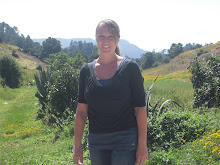Cuajimoloyas is a small mountain community in the state of Oaxaca with a population of 900. Its residents are Zapotecs, descendants of the ancient civilization responsible for constructing Monte Alban, the site of the ruins pictured in various photos on this blog. The older residents of the pueblo still speak Zapoteco, although younger generations generally speak Spanish. Until 40 years ago, there was no road leading to Cuajimoloyas. I had the opportunity to visit this community this past weekend, enjoying beautiful hiking trails and interesting conversations with members of the community.

Given that this is an indigenous community, the land is communal, and the pueblo has its own system of governing itself, separate from that of the state of Oaxaca. Each year the pueblo elects a “Municipal Agent,” who is essentially the leader of the community. The community is governed by “usos y costumbres,” a system of customary rules. A sense of community responsibility is intrinsic in these “usos y costumbres,” such as a requirement that each community member dedicate him or herself to community service full-time for one year, every two years. Such community service may include working at the school, in the government, constructing infrastructure such as roads, or working in the community’s Eco-Tourism department.

I was intrigued by the way that the community addresses conflicts, or violations of the law. According to the residents I spoke with, the community has very little conflict or crime. This is due in part because the community is close-knit; with a population of only 900, everyone knows one another. Further, family ties connect many community members. In addition, the community imposes strict consequences for violations, including permanent banishment from the community. A woman told me about an incident that happened a couple of years ago where 2 young men stole a chain saw that they found in the forest. The community had a meeting to determine the appropriate sanction, and the decision was that the young men be banished. Children are raised with the knowledge that failure to abide by the rules of the community will result in certain and swift punishment, including potentially being removed from the community.
Deterrence theory is an important criminological theory that asserts that future crime will be prevented if punishment is certain, swift, and appropriately proportional to the crime. Much of the current criminal justice system of the United States is built upon deterrence theory. I am of the opinion that policies based upon deterrence theory are largely ineffective in the context of the United States. Deterrence theory is based upon the premise that people understand the consequences of their actions before they decide to commit a crime, and that people engage in a rational cost-benefit analysis prior to deciding to commit a crime. This belief drives policies that continue to put harsher and harsher sentences on the books, under the guise that sentences must not be harsh enough if people continue to engage in crime. There are two major problems with this belief: (1) most people who commit crimes are unaware of the sentencing schemes written in the Penal Code; and (2) most people who commit crimes do not engage in this type of rational cost-benefit analysis prior to engaging in criminal behavior.
But deterrence theory does seem quite applicable in the context of Cuajimoloyas. Maybe because the community is involved in determining sanctions, as in the case of the community meeting that determined that banishment was the appropriate response to the theft of the chain saw. The public and inclusive nature of this process means that people are by and large aware of the consequences. In addition, the small population and importance of community norms and customs make deterrence theory more relevant in that people are more likely to be caught for wrongdoing, and consequences are more certain.





It is interesting that the context, in this case the nature of Cuajimoloyas, makes a difference in how deterence works. In the US we tend to think that one approach should fit all cases.
ReplyDelete